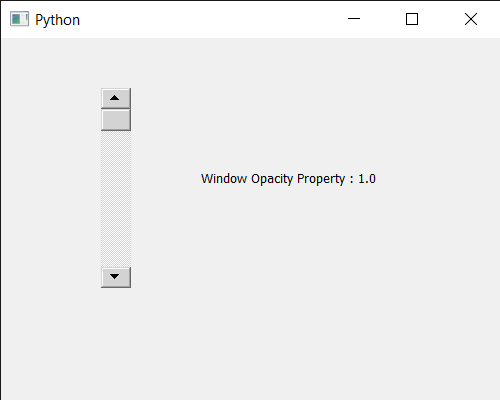PyQt5 QScrollBar – 获取窗口不透明度属性
在本文中,我们将了解如何获取 QScrollBar 的窗口不透明度属性。 QScrollBar 是一个控件,它使用户能够访问大于用于显示它的小部件的文档部分。 Slider 是栏内的可滚动对象。此属性保存窗口的不透明度级别。不透明度的有效范围是从 1.0(完全不透明)到 0.0(完全透明)。可以借助setWindowOpacity方法进行设置。
In order to do this we will use windowOpacity method with the scroll bar object.
Syntax : scroll.windowOpacity()
Argument : It takes no argument
Return : It returns float value
下面是实现
# importing libraries
from PyQt5.QtWidgets import *
from PyQt5 import QtCore, QtGui
from PyQt5.QtGui import *
from PyQt5.QtCore import *
import sys
class Window(QMainWindow):
def __init__(self):
super().__init__()
# setting title
self.setWindowTitle("Python ")
# setting geometry
self.setGeometry(100, 100, 500, 400)
# calling method
self.UiComponents()
# showing all the widgets
self.show()
# method for components
def UiComponents(self):
scroll = QScrollBar(self)
# setting geometry of the scroll bar
scroll.setGeometry(100, 50, 30, 200)
# making its background color to green
scroll.setStyleSheet("background : lightgrey;")
# setting window opacity property
scroll.setWindowOpacity(1.0)
# creating a label
label = QLabel("GeesforGeeks", self)
# setting geometry to the label
label.setGeometry(200, 100, 300, 80)
# making label multi line
label.setWordWrap(True)
# getting value changed signal
scroll.valueChanged.connect(lambda: do_action())
# method called when signal is emitted
def do_action():
# setting text to the label
label.setText("Current Value : " + str(scroll.value()))
# getting window opacity property
value = scroll.windowOpacity()
# setting text to the label
label.setText("Window Opacity Property : " + str(value))
# create pyqt5 app
App = QApplication(sys.argv)
# create the instance of our Window
window = Window()
# start the app
sys.exit(App.exec())
输出 : 